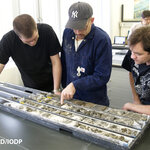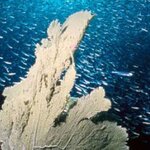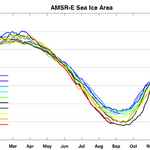Oceanography

A powerful earthquake has struck an hour ago, at 8.30UT, very close to the place where a similar event occurred on December 26th 2004. The earthquake has an estimated magnitude of 8.7 and occurred at a depth of 33km, according to NOAA. The map below shows the location of the event and the potentially affected areas.
Note that the wave is expected to arrive to Sumatra right now, at the time of writing this. It is not granted that an earthquake, even a powerful one such as the present one, will generate a train of tsunami waves; however it is quite likely that this is what is occurring. The…

A dramatic sea-level rise occurred at the onset of the first warm period of the last deglaciation, known as the Bølling warming, approximately 14,600 years ago. This event, referred to as Melt-Water Pulse 1A (MWP-1A), corresponds to a rapid collapse of massive ice sheets 14,600 years ago and resulted in global sea-level rise of ~14 m.
The Tahiti Sea-Level Expedition 310 of the Integrated Ocean Drilling Program (IODP) was carried out in 2005 by the European Consortium for Ocean Research Drilling (ECORD) and the ECORD Science Operator (ESO) on behalf of IODP.
Using uranium-thorium(U…

Christopher Sommerfield, associate professor of oceanography at the University of Delaware, has found a new way to study local waterways: radioactive iodine.
That's bad, right? Maybe not. Radioactive iodine is used in medical treatments and trace amounts are entering waterways via wastewater treatment systems. That means it provides a new way to track where and how substances travel through rivers to the ocean.
Sommerfield found small quantities of radioactive iodine, also called radioiodine or I-131, by accident while sampling the Delaware River, the main source of freshwater to…

In the cultural war over climate change, which is mostly about drivers but looks like politics, other aspects of earth science get lost, like that pollution is plain bad. The oceans may be acidifying faster today than they have in the last 300 million years and part of that reason is because the oceans act like a sponge to draw down excess carbon dioxide from the air.
'May' is one of those operative words scientists use that often get used colloquially to instill doubt, like how anti-science people on one side deny climate science and those on the other deny biological science.
The…
With the hundredth anniversary of the maiden voyage, and subsequent sinking, of the RMS Titanic (covering April 14th-April 15th, 2012) fast approaching, you probably expect someone in the world of 2012 to implicate global warming.
Donald Olson, a physics professor at Texas State University, has a more interesting idea. Along with fellow TSU member Russell Doescher and Roger Sinnott they lay out the hypothesis in Sky&Telescope that the Moon was involved. And the Sun too.
Olson previously solved the "strange huge meteor-procession" described in Walt Whitman's Leaves of Grass , the…
Fire in Brazilian Antarctic Base.
A fire has destroyed a major part of the Comandante Ferraz Antactic base, leaving two people dead and one injured.All of the scientists have been evacuated from the station.Some military personnel have been able to stay in Antarctica thanks to Chile's hospitality at their Eduardo Frei research base.
Image source: BBC News.
The family of Marine Sergeant Roberto Lopes dos Santos, who died at Comandante Ferraz Antarctic Station in Antarctica, while trying to extinguish a fire in the Brazilian base on Saturday, believe that his death was accidental and do not…
An underwater ridge may be the only thing holding back the retreat of Antarctica's fast-flowing Thwaites Glacier, which drains into west Antarctica's Amundsen Sea, and it could speed up within 20 years, says a new study in Geophysical Research Letters.
Thwaites Glacier is being closely watched for its potential to raise global sea levels as the planet warms but neighboring glaciers in the Amundsen region are also thinning rapidly, including Pine Island Glacier and the much larger Getz Ice Shelf. The study highlights the importance of seafloor topography in predicting how these glaciers will…

Arctic Ice October 2011
Ice extent, as measured down to 15% concentration, was only slightly above 2007 levels at the end of this year's melt season. The ice is now about as thin as in 2007, or thinner, and the age of remaining ice continues to decline. [edit: inserted missing clause - bolded.]
The summer sea ice melt season has ended in the Arctic. Arctic sea ice extent reached its low for the year, the second lowest in the satellite record, on September 9. The minimum extent was only slightly above 2007, the record low year, even though weather conditions this year were not as…

Arctic Ice September 2011
My March 2011 forecasts were quite wide of the mark. For the first part of the Arctic summer much of the western Arctic saw lower than expected temperatures. Despite the low temperature start-off, the Arctic is about to see either the lowest ever end of season extent, or the 2nd lowest since 2007.
In June, I wrote:
Much depends on the Arctic weather, but it looks likely that the September ice minimum will be amongst the three lowest. If the melt in July and August proceeds as it has done on average over the last decade, then the 2007 record minimum…

If you are worried about big changes in Arctic sea ice, you are not alone - but it is hard to know how much is worth worrying about. If you are worried, there is some slightly good news - even if we lose half, it will not be a 'point of no return' according to a new study.
Sea ice comes and goes without leaving a record so our knowledge about variations and extent was limited before we had satellite surveillance and observations from airplanes and ships. Not any more. Researchers at The Centre for Geogenetics at the Natural History Museum of Denmark, University of Copenhagen…